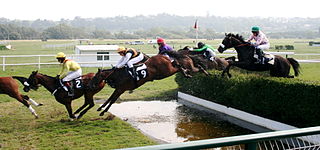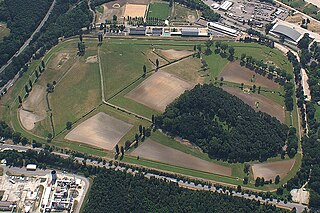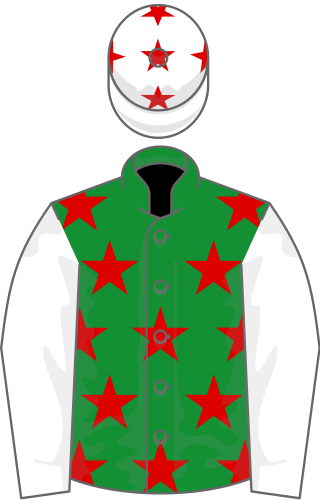The Race
Grenade was the early leader but was jostled at the third fence and lost his place, where Marengo was the first casualty. Jerry, Ballybar and two or three others led the runners to the first brook where they were hampered by other runners crossing their path to get a good position for the next fence the latter fell, running off to leave his rider on the ground for some time. At Valentine's brook several horses came into contact and Valeria fell. Cumberland Lassie had been among the leaders throughout but as she approached the Table top jump at Anchor Bridge crossing she struck a post and fell before running off the course onto the road beyond. [6]
The loose Marengo led the field to the Water jump where there was a fear he might swerve and hamper the leaders, but he stayed on course to lead Jerry over the fence, followed by Tramp, Clinker, St Leger, Pioneer, Culverthorpe, The Roarer, Avoca, The False Heir, Mathew, St Ruth and Brunette with these remaining the main contenders for most of the second circuit. Jerry's chance was lost when he over reached at the table top jump, narrowly avoiding falling, but left badly hindered. St Leger now appeared to the crowd to be on his way to victory until challenged and overhauled in the final strides by Mathew. Pioneer, Culverthorpe and Brunette were the only other official finishers, while Grenade, Cavendish, Pluralist, Tramp, Latitat, Young Lottery and Avoca all passed the post, having given up the chase at the final hurdle.
Aftermath
The win has gone down in history as being a hugely popular one among the Irish, bearing in mind that this was at the height of the Great Famine in the country. In truth the Irish press largely ignored the race in those days and it was only the wealthy friends of Mr John Courtenay in and around the County Cork area who benefited from the victory. In actuality Courtenay was considered among the most ruthless of the landowners who were, at this time forcibly evicting their tenants for being unable to meet their rent and as a result the rank and file Irishmen had placed their support with another Irish entrant Brunette. In the event, it was only this huge body of support from across the Irish sea, and one large wager in particular that saw her start at all as she was not considered in a fit state to race at all. [7] Later histories of the race state that she was tailed off for most of the race [6] but contemporary reports place her heavily involved in the front rank and her being recorded as a finisher support the contemporary accounts. [8]
Much of the early history of the Grand National was told many years after the events and often from memory with the result that the winner, Mathew appears on the winners board at Aintree carrying the modern spelling of Matthew. The sixth horse The False Heir is often recorded as a non finisher while the favourite The Roarer, along with Young Lottery are not recorded as having taken part at all. As a result, many modern books and websites state six finishers in a field of twenty-six runners instead of the seven from twenty-eight recorded by the press of the time.

The Grand National is a National Hunt horse race held annually at Aintree Racecourse, Aintree, Merseyside, England. First run in 1839, it is a handicap steeplechase over an official distance of about 4 miles and 2½ furlongs, with horses jumping 30 fences over two laps. It is the most valuable jump race in Europe, with a prize fund of £1 million in 2017. An event that is prominent in British culture, the race is popular amongst many people who do not normally watch or bet on horse racing at other times of the year.
National Hunt racing is a form of horse racing particular to France, Great Britain and Ireland, that requires horses to jump fences and ditches. In the UK it is divided into two major distinct branches, hurdling and steeplechase, as well as flat races called "bumpers". Hurdling involved the horses jumping over obstacles called hurdles, whereas in a steeplechase the horses jump over a variety of obstacles that can include plain fences, water jump or an open ditch. In the UK, the biggest National Hunt events of the year are generally considered to be the Grand National and the Cheltenham Gold Cup.

Aintree Racecourse is a racecourse in Aintree, Metropolitan Borough of Sefton, Merseyside, England, bordering the city of Liverpool. The racecourse is the venue for the Grand National steeplechase, which takes place annually in April over three days. Aintree also holds meetings in May and June, October (Sunday), November and December.

A steeplechase is a distance horse race in which competitors are required to jump diverse fence and ditch obstacles. Steeplechasing is primarily conducted in Ireland, Great Britain, Canada, United States, Australia, and France. The name is derived from early races in which orientation of the course was by reference to a church steeple, jumping fences and ditches and generally traversing the many intervening obstacles in the countryside.

Velká pardubická is a cross-country steeplechase run in Pardubice, Czech Republic since 1874. It takes place every year on the second Sunday in October.
The 1836 Grand Liverpool Steeplechase was the first of three unofficial annual precursors of a steeplechase which later became known as the Grand National.

The 1839 Grand Liverpool Steeplechase was the first official annual running of a steeplechase which later became known as the Grand National.
The 1840 Grand Liverpool Steeplechase was the second official annual running of a steeplechase, later to become known as the Grand National Steeplechase handicap horse race, which took place at Aintree Racecourse near Liverpool on Thursday 5 March 1840 and attracted a then smallest ever field of 13 runners.
The 1841 Grand Liverpool Steeplechase was the third official annual running of a steeplechase, later to become known as the Grand National Steeplechase handicap horse race which took place at Aintree Racecourse near Liverpool on 3 March 1841 and attracted a then smallest ever field of 11 runners.
The 1842 Grand Liverpool Steeplechase was the fourth official annual running of a steeplechase, later to become known as the Grand National Steeplechase, a horse race which took place at Aintree Racecourse near Liverpool on 2 March 1842 and attracted 15 runners.
The 1843 Grand Liverpool Steeplechase was the fifth official annual running of a handicap steeplechase, later to become known as the Grand National Steeplechase handicap horse race which took place at Aintree Racecourse near Liverpool on Wednesday 1 March 1843 and attracted a field of 16 runners.
The 1844 Grand Liverpool Steeplechase was the ninth annual running of a handicap steeplechase, later to be regarded as the sixth official running of the Grand National Steeplechase, a horse race which took place at Aintree Racecourse near Liverpool on Wednesday 28 February 1844 and attracted a field of 16 runners from a field of 41 entrants. It was won by the 5/1 co favourite, Discount, ridden by John Crickmere.
The 1845 Grand Liverpool Steeplechase was the seventh annual running of a Handicap Steeple-chase, later to become known as the Grand National Steeplechase, a horse race which took place at Aintree Racecourse near Liverpool on Wednesday 5 March 1845 and attracted a field of 15 runners. It was won by the unconsidered outsider Cure-All, ridden by William Loft in a record time of 10 minutes, 47 seconds.
The 1846 Grand Liverpool Steeplechase, later to become known as the Grand National Steeplechase, was the eighth official annual running of a handicap steeplechase. It took place at Aintree Racecourse near Liverpool on 4 March 1846 and attracted a then-record field of 22 entrants. It was won by the unconsidered outsider Pioneer.
The Canal Turn is a fence on Aintree Racecourse's National Course and thus is jumped during the Grand National steeplechase which is held annually at the racecourse, located near Liverpool, England. Named for the Leeds & Liverpool Canal which passes alongside the racecourse at this point, it is jumped twice during the race, as the 8th and 24th fences.

The 2003 Grand National was the 156th official renewal of the world-famous Grand National steeplechase that took place at Aintree at 3:45pm BST, on 5 April 2003.

The 2002 Grand National was the 155th official renewal of the Grand National steeplechase that took place at Aintree Racecourse near Liverpool, England, on 6 April 2002.
The 1849 Grand National Steeplechase was the 11th official annual running of a handicap steeplechase horse race at Aintree Racecourse near Liverpool on Wednesday, 28 February. It attracted a field of twenty-four competitors for a prize valued at £825.
The 1851 Grand National was, at the time, the 14th renewal of a handicap steeplechase horse race that took place at Aintree near Liverpool, England, on 26 February 1851. However, this was later retrospectively recorded as the 13th official running by the Steeplechase Calendar of 1864 when the race of 1838 was disregarded as official.
Valentine's Brook is a fence on Aintree Racecourse's National Course and thus is jumped during the Grand National steeplechase which is held annually at the racecourse, located near Liverpool, England. Originally named as the Second Brook, it was renamed after a horse named Valentine was reputed to have jumped the fence hind legs first in 1840. The horse eventually finished third. It is jumped twice during the race, as the 9th and 25th fences.






